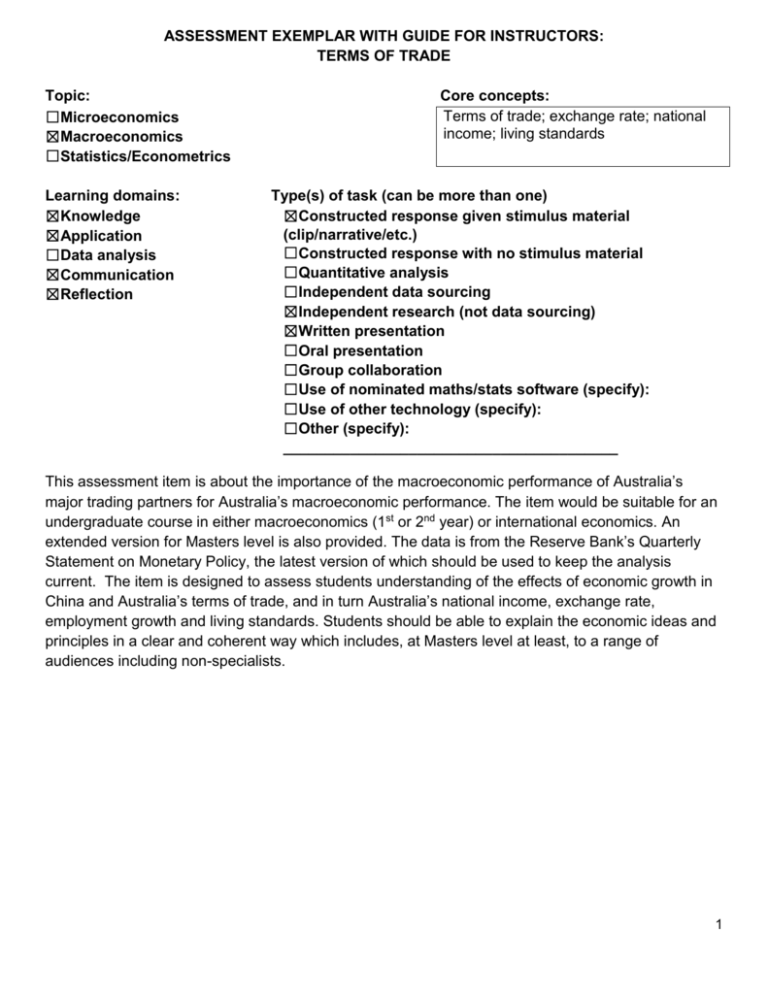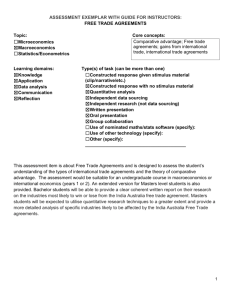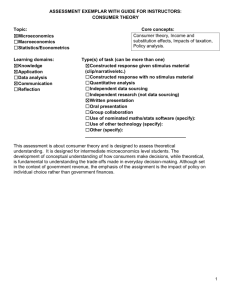Terms of trade
advertisement

ASSESSMENT EXEMPLAR WITH GUIDE FOR INSTRUCTORS: TERMS OF TRADE Topic: ☐Microeconomics ☒Macroeconomics ☐Statistics/Econometrics Learning domains: ☒Knowledge ☒Application ☐Data analysis ☒Communication ☒Reflection Core concepts: Terms of trade; exchange rate; national income; living standards Type(s) of task (can be more than one) ☒Constructed response given stimulus material (clip/narrative/etc.) ☐Constructed response with no stimulus material ☐Quantitative analysis ☐Independent data sourcing ☒Independent research (not data sourcing) ☒Written presentation ☐Oral presentation ☐Group collaboration ☐Use of nominated maths/stats software (specify): ☐Use of other technology (specify): ☐Other (specify): ________________________________________ This assessment item is about the importance of the macroeconomic performance of Australia’s major trading partners for Australia’s macroeconomic performance. The item would be suitable for an undergraduate course in either macroeconomics (1st or 2nd year) or international economics. An extended version for Masters level is also provided. The data is from the Reserve Bank’s Quarterly Statement on Monetary Policy, the latest version of which should be used to keep the analysis current. The item is designed to assess students understanding of the effects of economic growth in China and Australia’s terms of trade, and in turn Australia’s national income, exchange rate, employment growth and living standards. Students should be able to explain the economic ideas and principles in a clear and coherent way which includes, at Masters level at least, to a range of audiences including non-specialists. 1 Bachelors level task Consider the following two charts and answer the questions that follow: Source for charts: Reserve Bank of Australia, Statement on Monetary Policy, Feb 2015 2 Questions: (i) Imagine you are talking with a relative or friend who has no training in economics. In 200 words or fewer, explain to him/her the links between economic activity in China and Australia’s terms of trade. Avoid using economic jargon where possible. (200 words) [CB1, KB1, AB2] Now suppose you are an economist for a stockbroking firm and you are preparing a brief for clients on the importance of China for Australia’s macroeconomic performance. (ii) Explain the relative importance of the components of China’s GDP growth. Is this likely to change over the next two or three decades? Why? (200 words) [KB1, AB2, RB2] (iii) Consider the graph of Australia’s terms of trade. Critically evaluate the following statement, identifying any important assumptions or value judgements in your analysis: “The sharp rise in Australia’s terms of trade between 2001 and 2010 was unsustainable. The collapse was inevitable and the Government should have planned for the budgetary consequences.” (300 words) [KB1, AB2, RB1] (iv) Over the past two decades, explain in general terms how Australia’s terms of trade affect has affected its: national income exchange rate employment living standards (300 words) [KB1, AB2, RB2] 3 Masters level task The item could also be adapted as an exam question of, say, 30 minutes in length, by shortening the questions and/or dropping one or more questions. This Bachelor level item is presented here as a 1000 word assignment. It easily could be lengthened to a 2000 word assignment by, for example, adding a graph of the exchange rate and a graph of Australia’s GNP and asking for reference to these graphs in answering the questions. Masters level assignment (1500 words) Masters students would be expected to demonstrate a more advanced evaluation of: the sustainability of the rise in Australia’s terms of trade in the 2000’s decade, and an understanding of different interpretations of what is meant by sustainability of an economic variable; whether the fall in the terms of trade should have been foreseen by the Government and, if so, whether the Government should have built up larger surpluses in anticipation of the significant fall in company tax revenues from the decline in commodity prices. the macroeconomic effects of Australia’s terms of trade using diagrammatic analysis. The Masters level assignment has been extended to 1500 words to allow further depth of analysis. Masters level questions: Referring to the two charts above: (i) Imagine you are talking with a relative or friend who has no training in economics. In 200 words or fewer, explain to him/her the links between economic activity in China and Australia’s terms of trade. Avoid using economic jargon where possible. (200 words) [CM1, KM1, AM2] Now suppose you are an economist for a stockbroking firm and you are preparing a brief for clients on the importance of China for Australia’s macroeconomic performance. (ii) Explain the relative importance of the components of China’s GDP growth. Is this likely to change over the next two or three decades? Why? (400 words) [KM1, AM2, RM2] (iii) Consider the graph of Australia’s terms of trade. Critically evaluate the following statement: “The sharp rise in Australia’s terms of trade between 2001 and 2010 was unsustainable. The collapse was inevitable and the Government should have planned for the budgetary consequences.” Your answer should identifying any important assumptions or value judgements, and briefly define what is meant by “unsustainable” in this context:(400 words) [KM1, AM2, RM1] (iv) Explain, using diagrammatic analysis where appropriate, how Australia’s terms of trade affect has affected its: national income exchange rate employment living standards (500 words) [KM1, AM2, RM2] 4 Advice to assessors The charts should be updated using the RBA’s quarterly Statement on Monetary Policy. Re Q (i), advice should be given to students about the use of jargon and the style of communication to non-specialist audiences. Re Q(iii), advice should be provided about the meaning of “assumptions” and “value judgements”. For example, assumptions and value judgements are required in evaluating whether a terms of trade path is “sustainable”. This requires an explanation of what is a “sustainable” path of an economic variable. Students could comment, for example, that in a narrow sense the terms of trade might be regarded as sustainable if it can be maintained at its current level for a very long period of time. Or perhaps fluctuate around its current level? Students should identify any assumptions that this requires about the state of the world economy? Students could take a broader interpretation of a sustainable path for the terms of trade, for example in terms of the ability to maintain living standards of future generations. The latter idea is based on value judgements about intergenerational equity. 5 Learning domain Learning outcomes Bachelor Degree Masters Degree Knowledge KB1 Bachelor graduates will be able to identify, coherently explain and synthesise core economic concepts KM1 Masters graduates will be able to identify, coherently explain and synthesise core and advanced economic concepts, including recent developments in the discipline Application Bachelor graduates will be able to: Masters graduates will be able to: AB1• frame problems in terms of core economic concepts and principles AM1• frame and critically analyse problems in terms of core and advanced economic concepts and principles AB2• apply economic reasoning and analytical skills, in order to make informed judgments and decisions AM2• apply advanced economic reasoning and analytical skills, including quantitative techniques where appropriate, in order to make informed judgments and decisions AM3• plan and execute a research-based project Data analysis Bachelor graduates will be: Masters graduates will be able to: DB1• able to use economic data to address typical problems faced by economists DM1• select and apply an appropriate empirical method to address typical problems faced by economists DB2• aware of, and able to implement, basic empirical techniques and interpret the results DM2• critically evaluate the results Communication CB1 Bachelor graduates will be able to present a clear and coherent exposition of economic knowledge, ideas and empirical evidence both orally and in writing, individually or in collaborative contexts CM1 Masters graduates will be able to communicate complex ideas clearly and coherently, in written form and interactive oral form to expert and non-expert audiences, individually or in collaborative contexts Reflection Bachelor graduates will be able to reflect on: Masters graduates will be able to reflect on and evaluate: RB1• the nature and implications of assumptions and value judgments in economic analysis and policy RM1• the nature and implications of assumptions and value judgments in economic analysis and policy RB2• interactions between economic thinking and economic events, both historical and contemporary RM2• interactions between economic thinking and economic events, both historical and contemporary RB3• the responsibilities of economists and their role in society RM3• the responsibilities of economists and their role in society 6








